
Возможно, вы слышали, что у кошек девять жизней. Что ж, возможно, это правда, но одно можно сказать наверняка — ваша кошка может прожить долгую и здоровую жизнь при надлежащем уходе. При уходе за кошкой нужно учитывать множество факторов, и мы рассмотрим их все в следующих разделах:
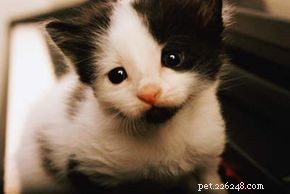
Прежде чем завести кошку, решите, какую кошку вы хотите:котенка или взрослую кошку; длинношерстный или короткошерстный; породистая или бездомная кошка; мужской или женский; полосатый, пятнистый или однотонный.
Если вы настроены на определенный размер, возраст, пол, породу или внешний вид кошки, проведите небольшое дополнительное исследование, прежде чем отправиться на ее поиски. Вы можете быть удивлены, обнаружив, что образ, который вам нравится, не соответствует вашему образу жизни. Например, если вам нравится тихий дом, сиамская кошка может вам не подойти:они известные «говоруны». Точно так же персидская кошка великолепна на вид, но если вы не собираетесь ухаживать за ней почти ежедневно (или платить профессионалу за это каждую неделю или около того), хорошая короткошерстная кошка может быть лучшей идеей. Ты много путешествуешь? Тогда вам нужна более зрелая кошка — не моложе восьми месяцев. Две кошки еще лучше, чтобы они могли составить друг другу компанию, пока вас нет.
Все любят котят. Они милые, забавные и приятные — в этом нет никаких сомнений. Но не делайте ошибку, что они «младенцы». К тому времени, когда котенок готов уйти от матери и жить в вашем доме, он уже может ходить, бегать, прыгать и карабкаться, как десятилетний ребенок. Более того, если вы купите котенка сегодня, всего через несколько месяцев у вас будет взрослая кошка, которая проживет в среднем от 12 до 15 лет.
Если у вас есть время, условия и энергия, чтобы вырастить котенка, обязательно сделайте это — это замечательный опыт. Просто помните, что котята требуют особого ухода. Они требуют много внимания. Им требуется рутинная ветеринарная помощь, состоящая из повторных прививок, дегельминтизации и стерилизации или стерилизации. Большинство молодых котят начинают ласковыми и пассивными, но им нужна некоторая социализация и дрессировка, чтобы оставаться такими; и даже все равно вы не узнаете, какой будет их взрослая личность, пока они не вырастут.
Наконец, очень маленькие дети и очень маленькие котята обычно плохо сочетаются. Приятно думать, что малыш и десятинедельный котенок могут «расти вместе», но на самом деле так не бывает. Через шесть месяцев этот маленький комочек шерсти, который ваш ребенок может носить с собой, вырастет во взрослую кошку весом более десяти фунтов, а вашему трехлетнему ребенку будет... три с половиной года!
В этих Соединенных Штатах, конечно же, нет опасности нехватки кошек — здесь много кошек, а затем еще несколько. В большинстве регионов страны вы можете просто открыть входную дверь на рассвете, и кошка, скорее всего, войдет до того, как вы закончите завтракать.
На самом деле, количество кошек вокруг ставит вас в затруднительное положение. Как выбрать правильный? Будет ли оно здоровым? Как насчет скрытых проблем со здоровьем или поведением? Что будет с кошкой, если в вашем доме что-то не получится?
Завести кошку — это не купить газонокосилку или фен; они не приходят с гарантиями. Все они разные, а это значит, что у каждого кота свои радости и проблемы. Тем не менее, источники для кошек должны помочь вам принять решение. Хотя источник не может обещать, что кошка никогда не заболеет, они могут предпринять шаги, чтобы дать кошке наилучшие шансы выздороветь. Хорошие источники для поиска подходящей кошки включают:
Друзья и соседи. Скорее всего, у кого-то из ваших знакомых есть кошка или котята, которым нужен дом. Во многих случаях лучше взять кошку у соседа или друга, особенно если это котенок из кошачьего помета вашего соседа или домашний питомец друга, страдающего аллергией. Ваши личные отношения с этим источником обычно означают, что вы также узнаете прямую историю об этой конкретной кошке. Тем не менее, несколько предостережений о том, чтобы получить кошку от друга или соседа:не ожидайте, что кошке будет оказана всесторонняя ветеринарная помощь, как кошке из приюта или заводчика, и будьте осторожны, не смешивайте деловые отношения с дружбой.

Приюты для животных. Ежегодно в приютах для животных усыпляют миллионы бездомных кошек. Усыновление из приюта спасает жизнь, освобождает место для другой кошки и является недорогим способом заполучить питомца с помощью недорогих прививок и стерилизации. Будьте готовы пройти через заявления и собеседования, некоторые из которых могут показаться слишком личными и напористыми. Не принимайте это на свой счет — у них есть на это веские причины. Кроме того, не забудьте проверить объекты и состояние усыновляемых домашних животных. Так как животные живут в тесной компании, болезни, глисты и блохи могут стать проблемой. Pet Finders (www.petfinder.org) ведет базу данных кошек, доступных для усыновления из местных приютов.
Заводчики. Если вы хотите породистую кошку, то это то, что вам нужно. Хорошие заводчики очень хорошо осведомлены о кошках в целом и их породе в частности, и очень внимательно относятся к тому, кому они продают своих кошек. Остерегайтесь «дешевых» чистокровных и «подвальных заводчиков» (людей, которые разводят только ради прибыли). Уважаемый заводчик заинтересован в поддержании высокого качества животного, ведет тщательный учет и обычно производит только один или два помета на племенную самку в год. Попросите направление заводчика от национальных ассоциаций породы, таких как Ассоциация любителей кошек (www.cfa.org).
Бродячие кошки. Иногда вам даже не нужно беспокоиться о том, чтобы найти подходящую кошку, подходящая кошка найдет вас. Многие люди клянутся, что это лучшие кошки. Когда вы берете бездомного, вам не нужно брать интервью или платить за усыновление, и, скорее всего, вы спасаете жизнь. С другой стороны, вам придется покрыть расходы на прививки, дегельминтизацию, стерилизацию и тому подобное. У многих бездомных животных есть другие проблемы со здоровьем, которые могут проявиться не сразу, а их лечение может оказаться дорогостоящим. Иногда местные общества защиты животных могут помочь с первоначальным ветеринарным уходом, или местная ветеринарная больница может предложить льготные цены на лечение подкидыша, но не рассчитывайте на это.
Еще одно важное решение, которое вам необходимо принять при выборе кошки, — это будет ли у вас домашняя или уличная кошка. Узнайте о последствиях каждого решения в следующем разделе.
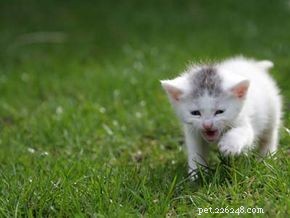
Возможно, нет ничего более жалкого, чем вой кота, который хочет оказаться по ту сторону двери. Когда это входная дверь, многие из нас понимают, что наши кошки не будут по-настоящему счастливы, если не выйдут на улицу. Но опять же, большинство кошек издают такой же шум, когда хотят войти внутрь (или, если уж на то пошло, когда хотят пройти через любую дверь). Действительно ли кошки хотят выйти на улицу? Им это нужно? И даже если ответ на оба вопроса «да», действительно ли это в их интересах?
Нужно ли кошкам выходить на улицу, как собакам?
Основная причина, по которой собак выгуливают, — это устранение, за которым следуют физические упражнения. Только самые маленькие собаки могут насытиться бегом в помещении. Собаки — стайные охотники, а это значит, что они работают сообща, чтобы довести добычу до изнеможения. Это может занять целый день, а это значит, что у собак есть естественный инстинкт бежать... и бежать... и бежать. Для такой работы нужно много открытого пространства. Кошки, с другой стороны, «охотники за засадами». Они полагаются на относительно короткие рывки очень быстрого бега. Коридор любой приличной длины предоставляет для этого достаточно места. Это в сочетании с инстинктом закапывать отходы (именно поэтому кошки будут использовать лоток) в целом не являются веской причиной выводить кошку на улицу.
Конечно, свежий воздух и солнце полезны всем — человеку или кошке. Но действительно ли жизнь на открытом воздухе более «естественна» для вашей кошки? Конечно, его дикие предки жили на открытом воздухе. Но это было несколько тысяч лет и несколько сотен поколений назад. Вдобавок ко всему, эти предки жили в засушливых районах Ближнего Востока, что сильно отличается от климата и окрестностей сегодняшних Соединенных Штатов. Как только кошки были приручены, они перестали быть полностью «естественными»; как только они были изгнаны из своей первоначальной среды обитания, им пришлось сделать все возможное, чтобы приспособить инстинкты, отточенные за десятки тысяч лет жизни в ближневосточных пустынях, к новым обстоятельствам. Некоторые из этих обстоятельств — лютый холод зимы на Среднем Западе, собаки и дикие животные, которые превратят их из охотников в добычу, мчащиеся автомобили и грузовики, и это лишь некоторые из них — они никогда не смогут по-настоящему приспособиться.
Что ждет вашу кошку прямо за вашей входной дверью? Да, здесь есть деревья и трава, а также все виды, звуки, запахи и радости природы — хорошие вещи, которыми мы все можем наслаждаться. Но есть также злые животные, жестокие люди, дорожные службы, болезни и сотрудники службы по контролю за животными (которые могут иметь законное право схватить и конфисковать вашу кошку, если она выйдет за пределы вашей собственности). Единственный надежный способ уберечь кошку от всех этих смертельных опасностей — держать ее дома.
По правде говоря, деревенские кошки не обязательно более безопасны на улице, чем городские. Конечно, в городе гораздо больше шансов быть сбитым машиной или растерзанным бродячей собакой. Но в сельской местности у нас есть несколько хищников, которые бегают больше, быстрее и сообразительнее, чем дикая городская собака. У нас также стало меньше света на дорогах, из-за чего бродячих животных стало труднее заметить, и их было легче сбить, а также, как правило, появилось больше видов болезнетворных насекомых, таких как клещи.
Для распространения целого ряда серьезных и смертельных кошачьих заболеваний требуется контакт с инфицированными кошками или места, где они часто тусуются. Вирус кошачьего иммунодефицита (FIV), вызывающий нарушение иммунной системы кошек, борющейся с болезнями, в основном передается через укусы инфицированных кошек. А вирус кошачьей лейкемии (FeLV) обычно требует длительного тесного контакта с зараженной кошкой, например, совместного использования лотков или мисок для еды и воды или взаимного ухода. Снова и снова риск заболевания незначителен или незначителен для домашних кошек, но значительно выше для уличных или домашних/уличных кошек. Владельцы кошек, особенно те, у кого есть маленькие дети, должны быть особенно осведомлены о том, что уличные кошки с большей вероятностью подхватят болезни и паразитов, которые могут поражать людей, от незначительных неприятностей, таких как блохи, до более серьезных заболеваний, таких как болезнь клеща Лайма, до чрезвычайно опасных состояний, таких как бешенство.
Тот факт, что вашей кошке безопаснее всего жить в помещении, а не бродить на свободе, не означает, что она никогда не сможет видеть дневной свет, кроме как через окно. Поводок и шлейка (не ошейник) — достаточно безопасный способ как для вас, так и для вашей кошки подышать свежим воздухом и погреться на солнышке. Прогулки на поводке — это приобретенный вкус, который некоторые кошки никогда не приобретут. Помогает регулярный опыт котенка, а некоторые кошки, приученные к поводку, даже просят прогуляться. Конечно, кошка на поводке по-прежнему рискует заразиться блохами, а также столкнуться с беспризорными кошками и собаками по соседству.
Построить кошачий загон на самом деле не так сложно, как кажется. Прогоны должны быть ограждены со всех сторон (включая верхнюю часть), прочно закреплены и сконструированы. Экраны должны быть самой толстой сеткой для улицы, а стены должны выступать на несколько дюймов ниже земли, чтобы кошки не могли прорыть себе выход или другие животные не могли прорыть себе путь внутрь. Если дорожка не пристроена к вашему дому с дверью для домашних животных или другой дверью, ведущей в помещение, убедитесь, что она включает в себя какой-либо обогреваемый, водонепроницаемый укрытие, в котором ваша кошка может укрыться в случае ненастной погоды.
Особенно важно, чтобы на беговой дорожке или другом открытом ограждении была крыша. Кошки — потрясающие альпинисты и прыгуны, и даже стена высотой от восьми до десяти футов может их не удержать, особенно если есть экраны, за которые можно зацепиться. Крыша и стены прогона также обеспечивают еще один вид безопасности — они защищают от других вещей. Отверстия в крыше или стенах позволяют недружелюбным или опасным животным, людям и вещам попасть в зону, из которой ваша кошка не сможет выбраться.
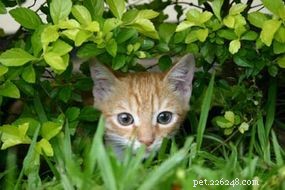
Свободно гуляющие кошки вступают в громкие ночные ссоры с другими кошками, жуют или выкапывают соседские растения, убивают местных птиц (но также могут помочь контролировать местную популяцию грызунов) и закапывают свои экскременты в чужих садах. В то время как некоторые люди — и некоторые владельцы кошек — считают это незначительными неприятностями, многие другие люди видят в них гораздо более серьезные проблемы. Если ваша кошка ввязывается в драку, она может не просто разбудить соседей своим воем и криком. Поверхностные царапины, которые вы можете увидеть на его лице или спине, не так уж плохи. Но у него также могут быть укушенные раны, которые быстро затягиваются, запечатываясь грязью и микробами и образуя болезненный абсцесс через несколько дней. Укусы во время драк также являются основным путем распространения кошачьего вируса иммунодефицита. Неизмененные кошки, которые свободно бродят, также способствуют перенаселению домашних животных, проблема, которая заполняет приюты для животных до отказа, в результате чего миллионы собак и кошек «усыпляются» каждый год.
Теперь, когда вы выбрали для себя идеальную кошку, пришло время научиться заботиться о ней. В следующем разделе мы начнем с советов по кормлению вашей кошки.

«Ты то, что ты ешь» — это здравый смысл, который справедлив как для вашей кошки, так и для вас. Кормите кошку качественной пищей, и у вас больше шансов вырастить здоровую кошку.
Производство кормов для домашних животных — это большой бизнес, и на то есть веские причины. В американских домах живет более 100 миллионов собак и кошек, плюс кто знает, сколько еще в приютах, питомниках и питомниках по всей стране. В довершение ко всему, у вас есть тысячи людей, которые кормят бездомных животных. Если вы подсчитали, что одна кошка может съесть около 90 фунтов или более кошачьего корма в год, мы говорим о сотнях миллионов долларов, которые ежегодно тратятся только на то, чтобы накормить котенка.
Как и в случае с человеческой едой, есть некоторые вкусные кошачьи лакомства, которые полезны для кошек, и некоторые вещи, которые в основном являются нездоровой пищей. Случайный перекус не очень полезными продуктами не должен причинять непоправимого вреда, но и не должен превращать его в постоянную часть рациона вашей кошки.
Дикие предки современной домашней кошки были охотниками — инстинкт, который сохранился и у вашей кошки. Приносит ли Табби в дар мертвых птиц и мышей или набрасывается на кусок ворса, она выражает мощное природное стремление выслеживать и убивать добычу. Если вы сомневаетесь, что ваша кошка прирожденный мясоед (и хищник), просто внимательно посмотрите на ее зубы в следующий раз, когда она зевает. Эти клыки не предназначены для поедания ростков люцерны.
Дело в том, что ваша кошка настолько плотоядна, что ей не выжить, если она станет вегетарианкой. Есть определенные питательные вещества, содержащиеся только в животных белках, которые необходимы вашей кошке. Одним из таких питательных веществ является аминокислота под названием таурин. Без таурина кошки могут ослепнуть, у них может развиться увеличенное сердце, которое, скорее всего, откажет им раньше времени. И, в отличие от собак, кошкам требуется диетический источник витамина А и жирной кислоты, называемой арахидоновой кислотой, которая содержится только в тканях животных. Вот почему вы никогда не должны кормить кошку собачьей едой. В собачьем корме просто не хватает нужных для кошек питательных веществ. На фунт может быть дешевле кормить вашу кошку собачьим кормом, но это может стоить вашей кошке здоровья, зрения или даже жизни.
Конечно, это не означает, что вы должны кормить свою кошку сырым мясом или позволять ей полагаться на охоту как на единственный источник пищи. Прошли сотни лет с тех пор, как кошки жили в дикой природе, поэтому их охотничьи навыки более чем заржавели. Кроме того, кошки, которые охотятся или едят сырое или недоваренное мясо, могут подхватить несколько видов болезней, в том числе некоторые, которые могут передаться вам.
Если он зеленый и растет из-под земли, велика вероятность, что какая-нибудь кошка попытается его съесть. Эта вегетарианская причуда в характере плотоядного кота особенно беспокоит, если речь идет о ваших любимых комнатных растениях или, что еще хуже, если они ядовиты для вашей кошки.
Многие владельцы кошек рассматривают поедание растений как поведенческую проблему, и если кошка ест растения, вы этого не хотите. Некоторые люди предполагают, что кошка, которая питается растениями, не получает достаточного количества правильной пищи в своем рационе. Они тоже правы, но только в том смысле, что в рационе кошки больше всего нуждаются... растения.
У экспертов есть несколько идей, почему кошки едят растения. Это может быть для получения некоторых микроэлементов, для помощи пищеварению или в качестве рвотного средства, чтобы помочь вывести проглоченные волосы и другие непищевые предметы. Какой бы ни была причина, поедание растительности является инстинктивным поведением кошек; Вы не можете остановить это. Так что лучше всего направить поведение в том направлении, в котором вы оба сможете жить.
Сажать "кошачий сад". Вы можете найти готовые наборы в зоомагазинах и каталогах, но более экономный выбор — просто сделать это самостоятельно. Если вы сообразительны, вы можете построить причудливый контейнер из дерева или просто использовать что-то под рукой. Что бы вы ни делали, убедитесь, что вы сажаете свой кошачий сад в контейнере, который не опрокидывается и не двигается. Все, что вам нужно, это всего лишь несколько дюймов хорошей почвы и несколько семян. Овсянка или кошачья мята — хороший выбор. Возможно, вы захотите держать сад вне досягаемости ваших кошек, пока ваш «урожай» подходит, но как только зелень вырастет на несколько дюймов в высоту, разложите ее и позвольте Табби жевать по желанию.
Уберите растения из зоны досягаемости. Кошки невероятно хорошо лазают и прыгают, поэтому размещение комнатных растений на подставках или полках, вероятно, не сильно поможет. Каминные полы, подоконники и тому подобное — удобные площадки для приземления кошачьих акробатов. Подвешивайте растения к потолку, размещайте их за непроницаемыми для кошек барьерами (например, на солнечной веранде, закрытой стеклянными дверями) или устанавливайте их в местах, куда ваша кошка абсолютно не сможет прыгать, взбираться или ползать.
Защитите свои растения. Если вы не можете убрать свои растения из зоны досягаемости котенка, попробуйте сформировать вокруг них защитный экран. Размещение проволочной сетки, маркеров для растений или даже шариков от нафталина в почве вокруг вашего растения может защитить его от любопытных лап, но эти барьеры не так красивы на вид. Попробуйте добавить немного испанского мха вокруг основания вашего растения, чтобы отпугнуть кошку. Иногда распыление биттера на листья отпугивает кошку от жевания. В других случаях, однако, добавление какого-либо неприятного на вкус вещества на растение наносит больше вреда растению, чем кошачьи зубы.
Сытой кошке не нужно больше перекусывать между приемами пищи, чем вам. Слишком частые перекусы окажут на кошку тот же эффект, что и на вас:нездоровое увеличение веса и несбалансированное питание.
Конечно, трудно устоять перед искушением угостить своего кошачьего приятеля время от времени — и вполне нормально поддаться этому искушению, при условии, что между «сейчас» и «потом» проходит достаточно большой промежуток времени. Как долго это зависит от вашей кошки и лакомств, которые вы ей даете. Если ваша кошка по-прежнему ест рекомендованное количество качественного корма для кошек каждый день и не имеет избыточного веса, то вы, вероятно, не даете ей слишком много лакомств. Если, с другой стороны, ваша кошка ест вкусные, но не очень питательные закуски и либо полнеет, либо воротит нос за обедом, пришло время изменить вашу стратегию.
Магазинные лакомства для кошек, как правило, не содержат полезных веществ. Их основная цель та же, что и у человеческих угощений:иметь приятный вкус — по-настоящему хороший — и это все. "Gourmet" cat snacks usually have fewer artificial colors and fillers in them but still aren't meant to be fed as a regular part of Tabby's diet. The good thing about "gourmet" treats is the cost:They're usually so expensive that cat owners won't overfeed them to their cats!
A question vets hear all the time is, "Can I feed my cat people food?" There's very little that people eat that cats shouldn't (or won't), so that's not really so much of a problem. (Cat owners should be careful about feeding dairy products to their pets. Although cats love dairy products, many don't digest them well and may get sick.) The question once again is nutritional balance. Just like with home cooking, feeding your cat leftovers or using people food for snacks may not be providing her with the right nutrients in the right amounts.
Still, people food might provide some of the healthiest snacks for cats. If you give your cat some scrambled eggs or a couple of pieces of pasta, at least you know what's in it. And you might be surprised what your cat will eat. Cat owners report their pets begging for predictable tidbits such as fish and chicken as well as unexpected ones, including tomatoes and cantaloupe.
Your cat needs about an ounce of water per pound of body weight every day. That doesn't sound like much, but it adds up:An average-size cat would need two quarts of water every week.
Of course, cats get water by drinking. But there's another important source of water for your cat:the food she eats. The more water there is in her food, the less she needs to drink. Canned cat food is more expensive because you're buying water along with the food (up to 75 percent of wet cat food is water) and paying a little more for the container. Dry cat food has much less water (perhaps 10 percent by weight), which means a cat whose diet consists of only dry food has to drink a lot more.
Dehydration (not enough water in the body) is a serious problem for any living creature, and cats are especially prone to it. A cat can go without food for days, losing up to 40 percent of her body weight, and still survive. But a loss of body water of only 10 to 15 percent can kill her. Other liquids -- like milk, if it doesn't make your cat sick -- are a good source of water, but nothing beats the real thing. Be sure your cat has plenty of clean, fresh water available at all times.
We will conclude our examination of cat food with a discussion of store-bought cat food vs. homemade cat foods in the next section.
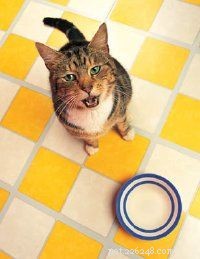
The best thing about a home-cooked meal is you're the one who gets to decide what's in it. If you're a steak-and-potatoes type, then you'll broil up a nice lean Porterhouse and a batch of new reds. On the other hand, if you go for a green salad, you can pick your dinner fresh from the garden. Trying to cut down on cholesterol and salt? When you're the cook, you make the call.
Unless you are a nutritionist or dietitian, however, you should let the experts -- the major pet food manufacturers -- prepare the major portion of kitty's diet. Working out the right amounts and balance of foods is a difficult task. Most food can get lumped into one or more of three categories of nutrition:protein, fat, and carbohydrate. Different kinds of animals (including people) need different proportions of protein, fat, and carbohydrate in their diets. (That's another reason why dog food isn't good for cats -- dogs and cats need different percentages of fat and protein to stay healthy.) What's more, those needs change during an animal's life. A kitten has different nutritional needs than an adult cat, and they both have different needs than an old codger cat. Most pet food companies have special formulas for different levels of age and activity, and there's a whole line of prescription diets for cats with various health problems.
We've all seen a cat come running at the sound of a can opener -- there's no doubt that kitty loves getting canned food. But is canned food better for cats than dry food? Не обязательно. Each type of food has its advantages and disadvantages. The most important factor is whether the food meets your cat's nutritional needs. Of course, your budget and your cat's preference also play a role in which type of food you should choose. Store-bought cat food comes in three general forms:
Each of these types of foods has its strong points and weak points. For instance, dry food is convenient, economical, and can be left out all day. On the other hand, the way some dry foods are formulated seems to encourage the formation of bladder stones. The rich aromas of canned food will tempt even the most finicky eater, but the crunchiness of dry food helps prevent dental plaque. Semimoist combines the convenience of dry food with the tastiness of canned food but may contain the most nonfood fillers and dyes.All brand-name cat food covers the basic nutritional needs of your average cat. But if you're worried about the overall quality of the boxes, bags, and cans of feline food in the pet supplies aisle of your local market, you might want to consider one of the premium-brand foods, usually found only in pet stores or through veterinarians. Feeding your cat store-bought food ensures that she is getting the nutrients she needs. At the same time, a home-cooked supplement to your cat's regular diet is okay if you make sure the foods you select are appropriate for cats. There's nothing wrong with getting the most out of a whole fryer by cooking up the gizzards for the cat, unless they become the major part of Tabby's diet. You see, organ meats (kidney, stomach, and even liver) are all right for your cat in moderation, but they've been linked to health problems if your cat eats too much of them. Likewise, every cat on the planet loves milk and cheese, but most cats have trouble digesting them well.In the next section, we will cover another very important aspect of cat ownership -- grooming.
What's In Cat Food?Careful consumers are label readers -- and that's a good place to start in figuring out just what you're feeding your cat when you buy cat food.Many pet owners compare the nutrition information on different brands of pet food and notice that a less-expensive brand has the same nutrients as a premium cat food. What that really means is that those two foods match up in the laboratory. For example, old shoe leather might rate as high as lean chicken breasts in protein content; of course, you and your cat would both rather eat chicken. So, what you need to know is how the various nutrients match up in your cat.You see, it's not how much of a particular nutrient there is in a can of cat food that matters but how much your cat's digestive system can take up. Cheap foods are usually made from cheap ingredients, which your cat may not digest well. Just because your cat gobbles it up and yowls for more doesn't mean a food is good for her. (Think about kids and junk food.)
The moral of the story is brand-name and specialty pet foods are made by companies that do a lot of research into pet nutrition. They're always improving their foods to keep pace with the latest information, and they use quality ingredients that have nutrients your cat can use. It may cost a little more, but it's worth it.
Прочитайте больше
Ever wonder why some cats always look sleek and beautiful and others look like...well, like something the cat dragged in? While it's true that some cats (like some people) are just born with "good hair," a lot of it has to do with grooming. Now, cats are fastidious critters. They tend to take care of themselves pretty well, always licking their fur to keep it clean and in its proper place. But any cat can go from Fluffy to Scruffy without a little help from her human pals.
The magnificent coat of a champion Persian is truly a work of art. But you'd better believe that it took hours of regular grooming to get it -- and keep it -- that way. It's common sense that the more hair there is to take care of, the more work that goes into it. The fluffier the cat's hair, the more likely it is to form mats, too. These thick tangles of hair can be painful and even tear a cat's skin if the mats get bad enough. Mats get embarrassing for a cat, too, since the only way to get rid of really bad ones is to shave them off. Nothing looks more uncomfortable than a cat who has been shaved.
It's not that shorthair cats don't need regular grooming or never get mats -- they do. It's just that their shorter, coarser outer coat requires lower maintenance than a long, silky coat. A shorthair cat who's diligent about her own grooming routine can do a lot to make up for an owner who's a little lazy with the brush and comb. But regular grooming is still a must for both longhair and shorthair cats.
Cats use their tongue and teeth for grooming. Every time Tabby goes into her contortionist bathing routine, she's swallowing hair. The more hair she has (and the more grooming she does), the more hair she swallows. Hair doesn't digest and can clump up in a cat's stomach and intestines to form hairballs. The least dangerous, but still rather unpleasant, side effect of hairballs is your cat coughing them up -- quite often at times or in places you'd much rather she didn't. On a more serious note, a lot of swallowed hair can actually block your cat's intestines, calling for an operation to save her life. The bottom line, as they say in the city, is to invest a few dollars in a brush and comb -- and use them.
Because longhair cats need regular grooming (with daily grooming really being the best), you might want to consult your budget before answering this question. But even if you have the means to bring your longhair cat to a professional groomer weekly, you should still have grooming tools on hand at home -- and know how to use them. You never know when your cat might get into something that needs to be combed out right away or when she might need a touch-up between trips to the groomer.
The main advantages of a professional groomer are training, skill, and experience. A good groomer can get your cat's coat looking spiffy quickly and humanely, with a minimum amount of trauma. Really bad mats and tangles can be dealt with at home, but if you've never done that sort of thing before, you run the risk of injuring your cat -- an injury that will probably need veterinary attention. Such grooming problems are probably best left to the professionals, too.
Even folks who learn to wield a slicker brush and metal comb with a good amount of expertise will turn to a professional groomer from time to time. It could be for a bad mat or tangle, during a particularly heavy period of shedding, or just to get the full treatment so that Tabby looks her best.
Every cat owner needs some grooming supplies. A metal comb is the most essential basic grooming tool. Sturdy stainless-steel combs with wide-set, round teeth are widely available and reasonably priced. A slicker brush has bristles that look like dozens of tiny bent nails. They resemble the rasps on a cat's tongue and serve the same purpose in grooming. Most cats enjoy the sensation of the slicker brush and the metal comb -- unless, of course, you hit a tangle or mat.
You may also want to invest in a flea comb, particularly if you let your cat outdoors, live in a year-round flea climate (like southern Florida or Louisiana), or have other pets who go outdoors. Flea combs look like metal combs but with very fine teeth set close together. Flea combs can be used for regular grooming, as a "touch-up" after the slicker brush or metal comb. Grooming mitts fit over your whole hand and let you work a larger surface while petting your cat.
Here are a few tips for home grooming:
Make it fun. Most cats love being stroked and enjoy the feeling of light grooming. It's good social behavior -- cats who get along well will blissfully groom each other for long periods of time. When it's time to do some grooming, approach your cat in a friendly way, and intersperse the grooming strokes with some regular petting.
Use restraint. It's okay to restrain your cat (gently!) as long as she doesn't start to panic, but be sure to restrain yourself, too. Don't try to force your cat to sit still or stay in an awkward or uncomfortable position for too long. And be careful not to get too exuberant in your grooming strokes. Think about how much you don't like having your hair pulled, then imagine what it's like to have hair getting pulled all over your body.
Know when to quit. You may not be able to groom your cat completely in one session. Это нормально. If you get her back and tail, and then she starts to fight you, give up and try finishing in a day or two. It's better to have a half-dozen five-minute grooming sessions spread out over a week and a happy cat than one 25-minute battle and a cat who runs and hides at the sight of the brush.
Get professional help. If your cat has a bad mat or tangle -- or gets something nasty on her fur -- put a call in to your veterinarian or professional groomer. If your cat just doesn't seem to be cooperating with home grooming, schedule an appointment with a professional. While you're there, ask for some tips and a demonstration of basic techniques. Groomers are usually happy to do this for clients; there's nothing more annoying for a groomer than having to constantly shave out and untangle bad mats. The cat suffers, and the groomer is more likely to get bitten or scratched.
Grooming is only part of the story, however. In the next section, we will look at some tips for bathing your cat.
How to Clip Your Cat's NailsYou can invest in specialized cat nail clippers if you'd like, but ordinary human nail clippers will work just as well. Restrain the cat with a gentle football hold. Gently squeeze the cat's toe between your thumb and forefinger, extending the nail. Gently clip off the sharp tip, being careful to stay in the clear portion toward the end of the nail (you should be able to see the reddish "quick" through the nail; don't cut this far or you'll cause discomfort and bleeding). Repeat with each toe.
No cat enjoys having her nails trimmed, but if you start them as kittens it will be easier when they're adults. Also be sure to play with your cat's paws and toes for fun sometimes, too; otherwise she'll always know you're going to cut her nails the minute you take hold of her paw.
Прочитайте больше
Except for removing a mat or performing a medical procedure, there is almost no other reason to shave a cat's hair. Cats are built to have a full coat of hair -- taking it away can throw off regulation of their body temperature and expose the usually protected skin underneath. Trimming a longhair cat's coat for appearances and to prevent tangles is fine, but it should be done by a professional groomer.
It's usually not necessary to bathe a cat, either, since they do so well keeping themselves clean. Sometimes, though, a bath is called for to treat or control fleas, to clean up an adventurous feline explorer, to treat a skin condition, or to remove a noxious or dangerous mess from your cat's fur. The squeamish, the inexperienced, and the uncertain should probably let a veterinarian or groomer take care of these mandatory baths. For those who want to try it at home, here are several bath basics.
Be prepared. Lay out your bathing supplies ahead of time. You'll need a good pet shampoo (get medicated shampoos for fleas or skin conditions from your vet, not over-the-counter); a large fluffy towel; a brush and comb; and either a handheld shower head or plastic tumbler for wetting and rinsing. It's a good idea to comb out your cat's hair before bathing, if possible, especially for longhairs. If you know how, now is the time to trim your cat's nails. (Note:You can protect your cat's eyes during a bath with a neutral ophthalmic ointment available from your veterinarian.)
Ready your bathing stations. Use a large sink with a dish sprayer attachment or the bathtub. Start the water before you put the cat in, and make sure it's not too hot or too cold. A comfortable temperature for your hands should work fine. You're going to get wet, splattered with suds, and possibly jumped on by an upset, sopping cat, so dress appropriately in clothes that can get soiled yet protect you from scratches.
Before you add the cat. Bathing a cat is often a two-person job -- one to restrain and one to bathe -- but you can do it yourself. Either way, practice restraint techniques on dry land before the bath. With one hand, grasp your cat firmly but gently at the base of the neck or on the scruff, pressing down slightly. See how well you can reach the various parts of your cat's body with the other hand. Figure out when and how you'll have to change grips during the bath. Get your bathing routine down step-by-step before the cat is in the tub or sink; otherwise, Tabby will be able to make a break for it in your moment of hesitation or confusion.
Start the suds. Wet down your cat, starting from the head and working your way to the tail. Apply the shampoo the same way, lather, and rinse thoroughly. (Read the label directions on medicated shampoos carefully. Some require 5 to 15 minutes before rinsing in order to be effective.) Thorough rinsing is important. Leftover soap residue can irritate your cat's skin or be swallowed when your cat licks her fur. Rinsing also gets rid of fleas and other parasites that are immobilized -- but not killed -- by the bath.
Drying a cat. Gently squeeze excess water out of your cat's fur, wrap her up in a large fluffy towel, and dry her off. If she'll stand for it, you can comb out any tangles right away; otherwise, wait until she's dried off and settled down. If you're lucky, your cat may tolerate the sound and feel of a blow dryer. Don't count on it, though -- many cats are terrified by them. This is not something to discover right after a bath. See how your cat reacts to the blow dryer on a non-bath day. If she's scared witless, stick with a towel. You might be able to gradually get her used to the sound and feel (especially if you begin regular baths in kittenhood) -- and then again, you might not!
A large part of keeping your cat healthy is removing potential dangers from your cat's environment. On the next page, we will show you how to cat-proof your home.
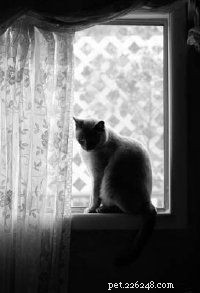
We all know to keep dangerous substances away from children, and it's important to remember that we should be even more careful with cats. We all know the old saying about what curiosity did to the cat. Because they are smaller, more mobile, and have more sensitive noses than children, cats are more likely to investigate, getting into things that can be dangerous. To prevent your cat's curiosity from becoming fatal, there are a few household dangers to look out for.
Drapery, blind, and electrical cords. To your cat's eye, the dangling end of a drapery or blind cord is an open invitation to play -- and possibly to disaster. Even just crawling between drapes or blinds and the window (an all-time favorite feline pastime) can land Tabby in a tangle. Cats who get caught in the loops of pull-cords panic. At the very least, the blinds or drapery rod will come down with a crash. At worst, a cat can strangle, do fatal internal damage, or actually get so worked up that his heart gives out. For maximum safety, tie or wrap all window cords well out of feline reach.
Electrical and telephone cords pose something of a tangling threat but more often are dangerous on account of chewing. It might be the taste or texture of the plastic coating, but for some reason, a lot of cats can't resist nibbling. There's not much direct danger in chewing phone cords (except when you try to make a call on a line that's been put out of commission by your cat) since there's very little current running through them.
Electrical cords are another story altogether, of course. Wherever possible, run the cords under rugs and carpets or behind furniture that sits flush to the floor and wall. If a cord has to be run where a cat can reach it, buy some inexpensive plastic conduit, which is available at most hardware and building supply stores. For a larger investment, you can get flat strips of heavy-duty vinyl that not only protect the electrical cords, but also keep the cords flush to the floor to prevent tripping.
Occasionally, a very determined cat will make his way through all the physical barriers. Treating the cords with a bad-tasting substance like bitter apple might do the trick. A little behavior modification, using positive reinforcement, will help, too.
Cleaning fluids, antifreeze, and other poisons. We don't just buy cleaners to get our house clean; we want it disinfected and smelling nice, too. Unfortunately, some of the very products we buy to sanitize and deodorize pet areas are outright dangerous for your cat.
Pine-based cleaners and those containing phenol (the most popular being Lysol disinfectant) are particularly toxic to cats and shouldn't be used on food bowls or in pet areas, sleeping quarters, or litter boxes. Of course, any cleaning compound can be poisonous if taken internally, so keep everything secured in a locking cabinet. (A simple spring latch won't keep a determinedly curious cat out.)
Ethylene glycol is the stuff that makes antifreeze work. It just so happens that it also smells and tastes very sweet. A significant number of cats and dogs -- and even small children -- suffer from ethylene glycol poisoning every winter. Because it's present in large amounts in almost every home and is often very fatal if swallowed, antifreeze and other products containing ethylene glycol should be considered dangerous and never left where pets or children can get to them.
Cats who go outdoors run the added risk of lapping up antifreeze spills and drips, an especially tempting thing for a thirsty cat to do since those puddles of tasty liquid don't freeze on cold days. You can protect your own cat (and other outdoor cats and strays) by immediately cleaning up and washing down any of your own spills or drips, or you can purchase one of the new nontoxic brands of antifreeze that contain propylene glycol rather than ethylene glycol. It's important to also keep in mind that once your cat leaves your property, there's no guarantee that everyone else in the area is going to be equally careful.
In general, anything that's toxic to you will be poisonous to your cat as well. The rule of thumb is:If you'd keep it out of reach of a child, keep it out of reach of your cat.
Poisonous plants. A cat chewing on your houseplants is more than an annoyance, it can be dangerous or even fatal to the cat.
Technically, any plant that makes your cat sick when eaten is a "poisonous" plant. (Nearly all cats will eat grass or plants to purge themselves, however, so vomiting alone may not be a reliable sign of poisoning.) Still, some plants have particularly serious effects. The list of potentially poisonous plants includes:apricot (pits), azalea, buttercup, caladium, calla lily, castorbean, cherry (twigs, leaves, bark, fruit, and stones), chrysanthemums, crocus, daffodil (bulbs), daphne (berries), holly, hydrangea, iris (leaves, roots, and fleshy parts), ivy, lily of the valley (leaves, flowers, roots), mistletoe (especially the berries), mushrooms, narcissus (bulbs), oak (acorns, young shoots, and leaves), oleander, peach (pits), philodendron, poison ivy, potatoes ("eyes" and sprouts from the eyes; the edible part of the potato is safe), privet, rhubarb (leaves), rosary pea (shiny red and black seeds), star of Bethlehem (bulb), string-of-pearls, sumac, and sweet pea (seeds and pods).
Dieffenbachia is a fairly common houseplant that also goes by the name of "dumb cane." The dumb cane is aptly named. Chewing dieffenbachia can actually paralyze your cat's mouth, making it impossible for him to eat and drink. The name "dumb cane" comes from the most noticeable effect of this paralysis on people:They can't talk.
Poinsettias (Christmas flowers) belong to the nightshade family -- flowers notorious in fact and literature for their deadly properties. A study a few years back seemed to show that poinsettias -- long believed to be dangerously toxic to cats and dogs -- don't make cats any sicker than many plants considered nonpoisonous. Still, it's always safest to keep cats away from any houseplant, just to be sure.
Windows, balconies, and screens. "High-rise syndrome" might sound like some sort of pop psychology explanation for violent crime, but it actually describes an epidemic that hits a number of cats every year, especially in warmer weather. "High-rise syndrome" is a collection of various injuries that are the result of a fall from a high window.
Amazingly, there are many stories of cats surviving falls from several flights up. But there are far more who fell and didn't make it. The saddest part of it is nearly all of those falls could have been prevented.
Every window that you plan to open needs to have a screen. And not just any screen. A cat-proof screen has to fit the window frame securely enough to stay firmly in place when confronted by ten or more pounds of cat. When ordering or replacing screens, use a heavy-duty grade of hardware cloth since ordinary screens can be easily torn by claws or teeth. Even a fall from a second- or third-story window can cause serious injury or death, so inspect all screens regularly, especially toward the end of winter in cold-weather areas of the country. Screens can warp, tear, or fatigue in the off-season.
Some city cat owners think letting Tabby out on the balcony of their apartment is a safe way to give him some fresh air and sunshine. Actually, a good number of "high-rise syndrome" cats were stalking moths, birds, or other irresistible things on an upper-floor balcony, when an ill-timed pounce or missed step sent them over the railing. Even a leash or tether on an open balcony doesn't ensure your cat's safety. A panicked cat dangling by his collar or harness can be strangled, seriously injured, or squirm loose and fall anyway.
Though you buy toys to amuse your cat, the wrong toy can be dangerous. In the next section, we will teach you what toys are safe for your cat.
The Animal Poison Control Hotline"My cat is a chowhound -- she never misses a meal," one cat owner recalls. "So when she didn't come running at dinnertime, I knew something was very wrong. I found her under the bed, and when I coaxed her out, she was staggering and drooling. I was terrified. She had this funny smell, which I recognized as the cleaning fluid I kept in my linen closet. I ran to the closet, and I found the door open and the can of cleaning fluid spilled on the floor.
"The problem is, we live a good 30 minutes from the nearest veterinarian. I didn't know how long she had been poisoned, and I wasn't sure that she had another half hour to spare. Then I remembered about the hotline -- and it saved my cat's life."
The ASPCA National Animal Poison Control Center (also called the Animal Poison Hotline) is operated by the University of Illinois College of Veterinary Medicine. Call 1 (888) 426-4435. There's a $55 flat fee, chargeable to a credit card (have your charge card ready). For more information, contact ASPCA Animal Poison Control Center (1717 South Philo Rd., Suite 36, Urbana, Illinois 61802).
Прочитайте больше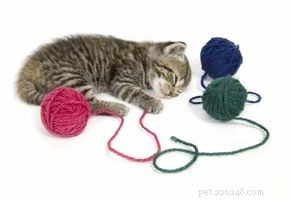
It's like something right out of a Norman Rockwell painting:a fuzzy little kitten tumbling around with a ball of yarn. Well, old Norman apparently never had to rush his cat to the vet for emergency surgery to get a couple of feet of that yarn unraveled from the poor cat's digestive tract. Yarn and string can turn even the most disinterested cats wide-eyed and playful but should never be left where cats or kittens can get at it on their own. Besides choking and intestinal blockage dangers, a cat who gets tangled up in string or yarn -- even during supervised play -- can panic and injure himself, possibly fatally. Take special care to keep sewing thread and dental floss out of feline reach; it's much finer and can become imbedded in the tissues of your cat's mouth, stomach, and intestines.
Cats will turn anything shiny, crinkly, or small enough to bat across the floor into a toy. Since Tabby doesn't have hands, he has to pick up these makeshift toys in his mouth, where they can be easily swallowed (or if not easily swallowed, can cause choking). At best, a foreign object in your cat's digestive system can trigger vomiting or diarrhea, but it can often be much worse. Keep things like paper clips, foil, and rubber bands safely tucked away.
Cellophane candy wrappers are particularly dangerous. Cats can't resist the crinkly texture, and the sugary residue makes them a cinch to get eaten. The wrappers can liquefy in your cat's stomach, coating the lining and blocking the uptake of nutrients from food.
What makes for a safe cat toy? Here's what to look for:
Something sturdy. If it can get tossed, thrown, gnawed, clawed, batted, kicked, licked, and repeatedly pounced on without coming apart, it's a good cat toy. Catnip-filled toys encourage play, but most cats like to eat catnip and will try to lick and chew their way to that scrumptious herbal filling. Catnip toys made from light fabric or felt will most likely be in shreds--and the shreds in your cat's tummy -- within a week. Ditto for plastic or vinyl toys that can be chewed up, cracked, or shattered.
No (re)movable parts. Catnip mice with yarn tails; crinkly cater- pillars with bug eyes; oversized plush "bumblebees" with glued-on felt features, and plastic mesh balls with tantalizing little bells inside are four of the more popular cat toys. But they share a common failing:small and potentially dangerous parts that come off. If you can pull or peel a part or decoration off a cat toy, the odds are your cat can, too. In fact, go ahead and try it with all your cat's toys -- it's better to have some catnip mice without tails than make a trip to the vet to get the tails out of your cat's stomach.
Something fun. A toy just isn't a toy if your cat won't play with it. Cat owners are often disappointed--and frequently annoyed -- to find that the $100 worth of custom cat toys they bring home get passed over for a piece of crumpled paper or a simple table tennis ball. Cats like games that involve what they do best:climbing, running, leaping, stalking, and pouncing. Pick toys that encourage those behaviors, and your cat is bound to use them. That's the allure of the table tennis ball -- it rolls and hops and skitters away when your cat pounces on it, encouraging batting and chasing. Cats see moving edges better than stationary objects, so toys that wiggle, bob, or weave fascinate them and trigger the stalking and hunting reflexes.
In our final section, we will cover perhaps the most important part of caring for you pet -- finding a good veterinarian. Finding a good vet for your cat is just as important as finding a good doctor for yourself.
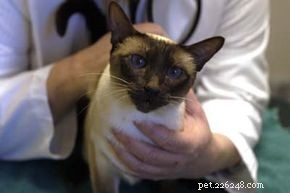
Choosing a veterinarian for your cat is a lot like choosing a doctor for yourself. You want someone with a good bedside manner and someone you like and trust. If you have special needs, you also want a doctor who understands and keeps those needs in mind.
If you're a first-time cat owner, have recently moved to a new area, or need to find a new veterinarian, you can just try opening the Yellow Pages to "Animal Hospitals." All veterinarians go to school as many years as medical doctors and have to meet strict standards for licensing, so you're bound to find a competent and professional vet that way. But the relationship among you, your pet, and your vet is going to last for many years, and if you took the time to find just the right cat, it makes sense to find the right vet. This might be the one area where city folk have it over country folk. A small town may just have one vet, while a big city has dozens within several miles.
Besides the Yellow Pages, here are some other sources for finding a good veterinarian:
Contact professional organizations. The American Veterinary Medical Association (www.avma.org) can refer you to affiliated veterinarians in your area, and the American Animal Hospital Association (www.aahanet.org) can direct you to clinics that meet its standards. The AVMA can also help you find feline specialists, behavior experts, veterinary eye doctors, and other professionals. Like any specialist, though, expect to pay heftier fees.
Get recommendations from other "cat people." Friends, family, and neighbors who have cats usually also have veterinarians. Take advantage of their experience, and get recommendations from them.
Once you get a referral for a veterinarian, call up, introduce yourself, and find out when you can drop by to see the facilities and meet the doctors. Make your visit brief but thorough. Be discriminating, but don't be put off if the vet and the clinic staff can't spend a long time with you -- they do have a hospital to run and patients to take care of. If you have a lot of questions and need the vet's undivided attention, the most polite thing to do is make an appointment -- and offer to pay for it.
If you are going to drop by the facility and meet with the vet, here are some items to consider:
Feline Vaccinations What exactly are vaccinations, and how do they help keep cats healthy? Here's how most vaccines work. Researchers find the germ causing the disease--for example, the virus that causes feline distemper. Next they produce a harmless, noncontagious version of the virus. This form of the virus is used to vaccinate healthy cats. The vaccine triggers the cat's disease-fighting immune system, which attacks and destroys the virus. This exposure "primes" the immune system so that if the same virus shows up again -- even the dangerous, contagious version -- it will be destroyed before it can cause illness.Vaccines protect your cat from common diseases, mostly caused by viruses. When a virus invades an animal's body, no medicine can kill it. You can give a cat with a virus things like antibiotics from now until doomsday, and it won't cure the disease (although the antibiotics will help treat or control infections that might start as a result of the cat's being sick with the virus). Viral diseases just have to run their course, after which the victim is often immune for life. Vaccines (usually with regular booster shots) provide your cat with the benefits of being immune without actually having to suffer through the disease.
Vaccines can't cure diseases caused by viruses. Going back to feline distemper for a moment, if a cat has already contracted this disease, the vaccine won't stop it. Vaccines also can't prevent every viral disease every time. No vaccine is 100 percent effective, so every once in awhile a cat who has all his shots will still get sick with something he's supposed to be protected against. Some diseases, like FIV, are caused by viruses that shut down the immune system when they first enter the cat's body. In those cases, the vaccine can't do its job because its tools (the disease-fighting system of the cat's body) have been taken away.
Get your cat's shots from a veterinarian or animal hospital. At the bare minimum, cats should be up-to-date on their rabies shot and distemper-combination vaccine. The combination shot usually carries protection against feline distemper (panleukopenia) and common upper respiratory diseases that cause cold- or flu-like symptoms in your cat (feline viral rhinotracheitis, calicivirus, and chlamydia). Vaccines may be given as an injection under the skin or in the muscle or as an aerosol administered directly into the cat's nostrils.
Any cat being vaccinated for the first time usually needs a series of shots, spaced several weeks apart. For kittens, these shots start at seven or eight weeks of age and continue until they are four months old. Rabies vaccines are given as one shot administered initially to a kitten over three months of age and to adults of any age. The American Association of Feline Practitioners recommends that subsequent boosters for many diseases (depending on the type of vaccine used) be given a year from the initial series and then every three years thereafter. Check with your veterinarian for vaccine scheduling recommendations for your cat.
Vaccines for other cat diseases have been around since the mid-1980s, particularly the one for feline leukemia virus (FeLV). FeLV (or FeLeuk, as it's sometimes known) attacks a cat's white blood cells and can produce a kind of cancer. Research shows that most cats exposed to FeLV don't get sick, but even infected cats who appear healthy can still pass the virus on to other cats. Once a cat does get sick from FeLV, though, the odds of recovery are poor.
The FeLV is a funny creature -- it doesn't last long outside of a cat's body, unless it stays a little moist. So the most common way FeLV gets passed is prolonged close contact between a healthy cat and infected cat -- things like mutual grooming, or sharing food, water, or litter boxes. This also means that the FeLV vaccine may not be necessary for a cat that is never exposed to FeLV-infected cats. A simple blood test can determine if your cat (or any new cat you're thinking of taking into your home) is infected. If not, keeping your FeLV-free cats indoors and away from FeLV-infected cats is probably all the protection they need (outdoor or indoor/outdoor cats are a different story). If your cat tests positive for FeLV, the vaccine won't help, either; vaccines don't kill the virus, they only protect uninfected cats from getting it.
Feline immunodeficiency virus (FIV) and feline infectious peritonitis (FIP) are also fatal cat diseases caused by viruses. There are laboratory tests for their detection, but the test used currently for FIP can give inconclusive results. Vaccines exist for FIV and FIP, but the jury is still out on their effectiveness in preventing disease transmission. Your veterinarian can help you figure out if your cat is at risk for these diseases and if the potential benefits of each vaccine outweigh the risks.
While you will face many challenges as a pet owner, you now know the basic care tips that every cat needs to be happy and healthy.
Publications International, Ltd.

Как кормить кошку из шприца Котята и кошки могут откладывать прием пищи по ряду причин. Иногда это связано с возрастом, у пожилых кошек это может быть связано с операцией или болезнью. Это не означает, что ваша кошка должна голодать, пока не сможет прокормить себя. Что вы можете сделать, так это к
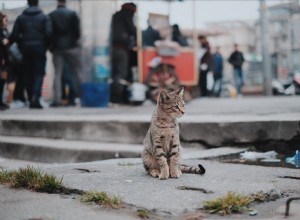
Все, что вам нужно знать о 5-недельных котятах Если вы были в моем блоге, то знаете, что недавно я спасла и приютила осиротевшего котенка. По нашим оценкам, мы получили ее около трех недель, и на протяжении всего этого процесса у нее было большое пробуждение. Я хотел познакомить вас с информаци